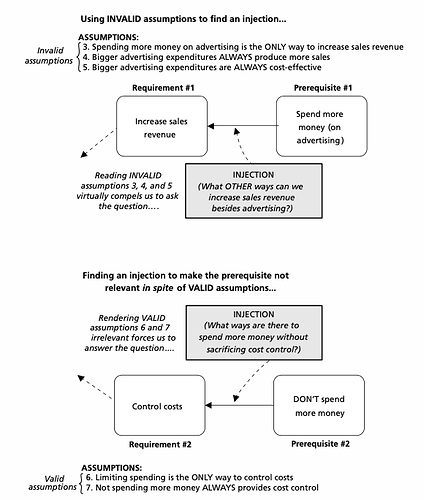a tool for conflict resolution Evaporating cloud
One of the reasons behind UDE is that one o several processes impede development of the system. Some hidden conflict slows down changing speed or completely blocks it. Evaporating cloud resolves the conflict in a win-win manner and sometimes is called a conflict resolution diagram.
EC opens an opportunity to create a playground to ideas that might evolve into solution to a complex problem.
- The purpose of EC
- Confirm an existing conflict.
- Articulate conflict that perpetuates a major problem.
- Find all assumptions around conflicting situation.
- Resolve.
- Avoid compromise.
- Create win-win solutions.
- Create ideal objects. Major breakthrough.
- Explain in depth reasons behind a problem.
Before continuing with evaporating cloud we need to state some assumptions regarding it:
- Problems are born from competition between two forces.
- Competition at some point in the future evolve into problem.
- Conflicts in any systems is an indication of suboptimization.
- Conflict more often than not invisible, confrontational or obvious.
- Competition at some point in the future evolve into problem.
- System goals require achieving more than one underlying conditions.
- Conditions are driven by prerequisites.
- Prerequisites is a level of a conflict. (Later on that. Zigzagged arrow).
- Conditions are driven by prerequisites.
- Conflicting forces exist on several layers
- functionally
- organizationally
- Sources of conflict might be
- in policies
- in human relationships
- Conflict results from underlying invalid or no longer relevant assumption.
- Conflict resolutions lies in breaking or invalidating assumption or opposing force.
- Assumption underlying conflict can easily be identified and determined.
- Conflict frequently involves complex interaction among several factors. Not bipolar.
- There are no “Silver Bullets”. No way of solving problem with one determined leap.
==Ideas are just ideas even ingenious, in order to implement them you have to find a solution.==
- True conflict resolutions is not consensus or rationalization or win or lose. Resolution is when you’ve resolved all sides of the conflicts and not sacrificed one for the other.
- More often than not conflict is subtle. Differences in opinions or views and experience.
There are two types of conflicts.
- Opposite conditions
- Sth forces us to do, sth prevents our actions.
- Different alternatives
- When we have two mutually exclusive paths. If we see either-or conditions it is a hidden conflict.
- Indication of hidden conflict.
- Sense of stagnation, instead of breakthrough nothing happens no matter how mush effort is put.
- One way to confirm stagnation – look at the time schedule of management. What they do with their time and energy?
- Indication of hidden conflict.
- When we have two mutually exclusive paths. If we see either-or conditions it is a hidden conflict.
- Breakthroughs solutions are:
- challenging
- nontraditional
- ideal
- not the way it was always done.
Breakthrough solutions are difficult to find, hard to implement. But they are simple at the core. To find them it’s good to look into TRIZ, Crawford’s slip method, creative thinking and lateral thinking also problem-solving and decision-making strategies might come in handy.
- Elements of Evaporating cloud
- One key objective
- Safe bet is to use goal from the [[Intermediate Objectives map]]
- Two necessary sufficient requirements
- Are usually critical success factors from the same [[Intermediate Objectives map]]
- Two conflicting prerequisites
- These are the actions that have to be made to satisfy requirements.
- Underlying assumptions
- A key to unlocking the conflict.
- Brainstorming or [[Метод записок Кроуфорда]] means of idea generation.
- If don’t have an invalid assumption to begin with, try invalidating some on purpose.
- The most common place to look for invalid assumption is between prerequisites.
- A key to unlocking the conflict.
- One or more injections (Breakthroughs)
-
EC has only five arrows. Theoretically, we can break any of them.
-
- Injection articulate specific action to take. Better discrete action. Easier to execute but not always possible and maybe not advisable.
- No silver bullets.
-
- One key objective
It is better to extract EC from CRT and do not clutter the latter with additional entities that do not belong there. What’s more important, they activate different cognitive processes and have different aims. ![[EC scheme.png]]
==Symbology==
[[Symbology EC.png]]
The source of conflict is usually a core root cause, negative branch from the tree.
NC are expressed in statements:
- “In order to … we must …”
- Read EC not in the direction of arrows, but in the opposite direction.
==CONSTRUCTION OF AN EVAPORATING CLOUD==
- The idea behind EC is to put in front of each other two competing forces. Represent the dilemma we are plagued with.
- Both positions must be placed into prerequisites boxes at the tail of the EC diagram.
- And clearly articulated, with five words or fewer.
- Use actions verbs. If you articulated one side of the conflict but have trouble with the other, ask yourself a question “What stops me from going this path?”
- “Needs” have to be determined.
- They must be non-negotiable, NC.
- Read the cloud backwards, “in order we must”. It is also good practice of validation of the whole EC.
- Develop underlying assumption.
- Each arrow has at least one assumption.
- Use extreme wording in articulation. Be as critical as possible.
- Quantifiers are best suited for such task: never, always, absolutely, absolutely impossible.
- Prohibitions are OK too, MUST
- Injections or breakthroughs must render the conflict.
- They can be either conditions or actions.
- TRIZ is the best source to look for inspiration. [DOMB and Terniko]
After we solved problems with all conflicts, resolved all opposition its time to start drawing future reality tree


